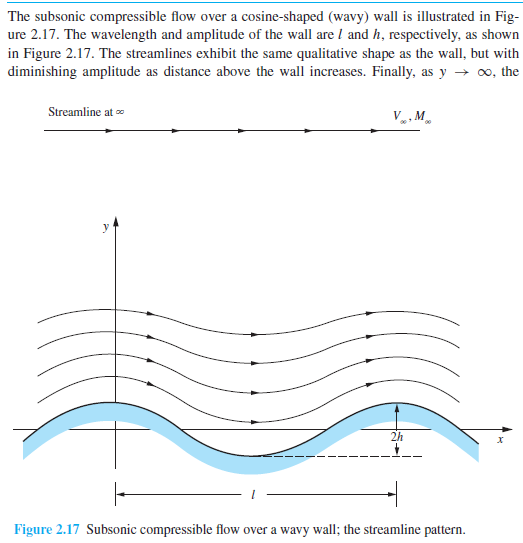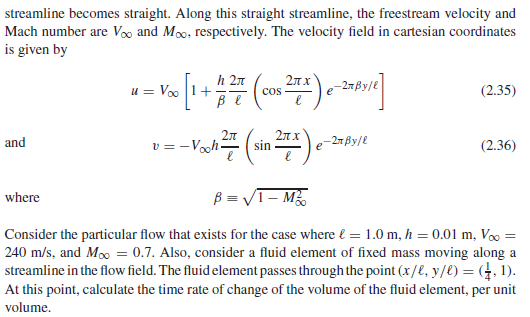The subsonic compressible flow over a cosine-shaped (wavy) wall is illustrated in Fig- ure 2.17. The wavelength and amplitude of the wall are I and h, respectively, as shown in Figure 2.17. The streamlines exhibit the same qualitative shape as the wall, but with diminishing amplitude as distance above the wall increases. Finally, as y → 0, the Streamline at V , M. 2h Figure 2.17 Subsonic compressible flow over a wavy wall; the streamline pattern. streamline becomes straight. Along this straight streamline, the freestream velocity and Mach number are Vo and Mo, respectively. The velocity field in cartesian coordinates is given by h 2n u = Voo 1+ 2лх -2т Ву/е cos (2.35) ве v =-Voh 2л sin and e-27By/e (2.36) B = VT- M where Consider the particular flow that exists for the case where l = 1.0 m, h = 0.01 m, V = 240 m/s, and Mo = 0.7. Also, consider a fluid element of fixed mass moving along a streamline in the flow field. The fluid element passes through the point (x/E, y/€) = (4, 1). At this point, calculate the time rate of change of the volume of the fluid element, per unit volume.
The subsonic compressible flow over a cosine-shaped (wavy) wall is illustrated in Fig- ure 2.17. The wavelength and amplitude of the wall are I and h, respectively, as shown in Figure 2.17. The streamlines exhibit the same qualitative shape as the wall, but with diminishing amplitude as distance above the wall increases. Finally, as y → 0, the Streamline at V , M. 2h Figure 2.17 Subsonic compressible flow over a wavy wall; the streamline pattern. streamline becomes straight. Along this straight streamline, the freestream velocity and Mach number are Vo and Mo, respectively. The velocity field in cartesian coordinates is given by h 2n u = Voo 1+ 2лх -2т Ву/е cos (2.35) ве v =-Voh 2л sin and e-27By/e (2.36) B = VT- M where Consider the particular flow that exists for the case where l = 1.0 m, h = 0.01 m, V = 240 m/s, and Mo = 0.7. Also, consider a fluid element of fixed mass moving along a streamline in the flow field. The fluid element passes through the point (x/E, y/€) = (4, 1). At this point, calculate the time rate of change of the volume of the fluid element, per unit volume.
Related questions
Question

Transcribed Image Text:The subsonic compressible flow over a cosine-shaped (wavy) wall is illustrated in Fig-
ure 2.17. The wavelength and amplitude of the wall are I and h, respectively, as shown
in Figure 2.17. The streamlines exhibit the same qualitative shape as the wall, but with
diminishing amplitude as distance above the wall increases. Finally, as y → 0, the
Streamline at
V , M.
2h
Figure 2.17 Subsonic compressible flow over a wavy wall; the streamline pattern.

Transcribed Image Text:streamline becomes straight. Along this straight streamline, the freestream velocity and
Mach number are Vo and Mo, respectively. The velocity field in cartesian coordinates
is given by
h 2n
u = Voo 1+
2лх
-2т Ву/е
cos
(2.35)
ве
v =-Voh
2л
sin
and
e-27By/e
(2.36)
B = VT- M
where
Consider the particular flow that exists for the case where l = 1.0 m, h = 0.01 m, V =
240 m/s, and Mo = 0.7. Also, consider a fluid element of fixed mass moving along a
streamline in the flow field. The fluid element passes through the point (x/E, y/€) = (4, 1).
At this point, calculate the time rate of change of the volume of the fluid element, per unit
volume.
Expert Solution
This question has been solved!
Explore an expertly crafted, step-by-step solution for a thorough understanding of key concepts.
This is a popular solution!
Trending now
This is a popular solution!
Step by step
Solved in 2 steps with 2 images
